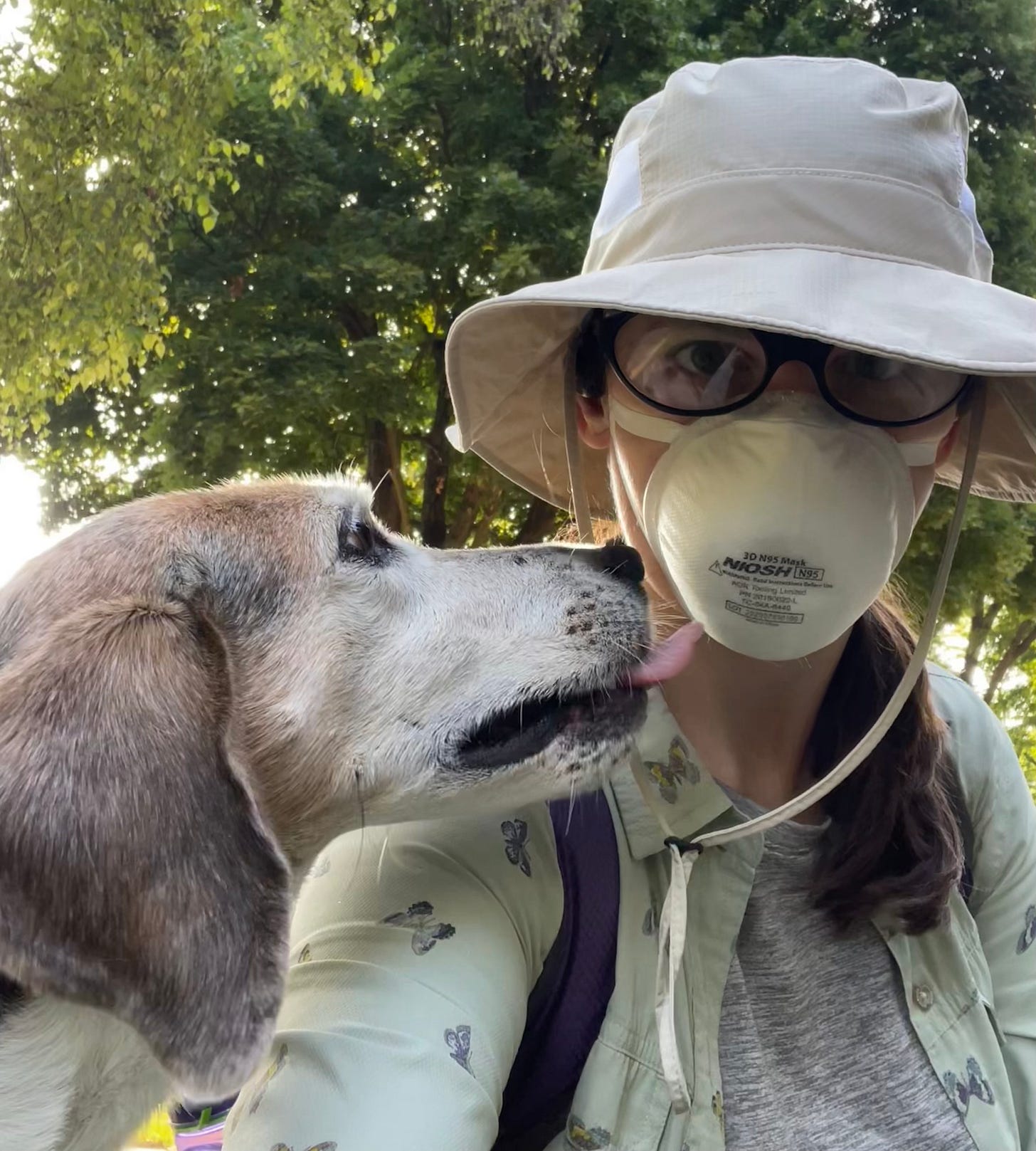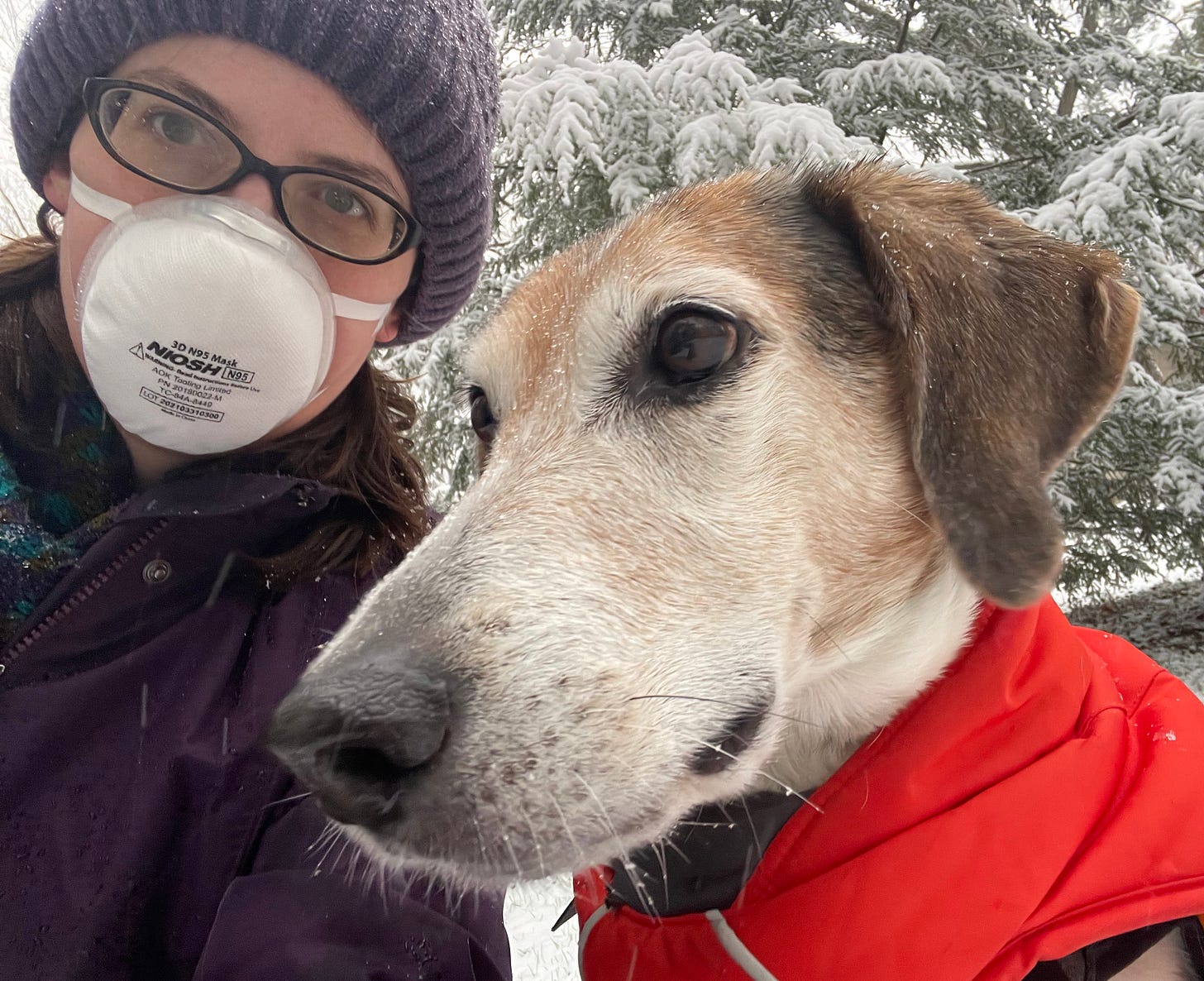Happy National Dog Day! 🐶
Masked dog walks, clear the shelters campaign, and challenges and rewards of pet ownership in the ongoing pandemic
Today is National Dog Day in the US! I start almost every day with a masked dog walk around my neighborhood.

If you mask indoors but don’t wear a mask on your dog walks, I recommend having one in your pocket or bag, just in case! Outdoor masking with high quality respirators (KN95, N95, or better) doesn’t just reduce the risk of COVID transmission—it also reduces exposure to allergens, pollutants, and wildfire smoke. Added bonus—the mask keeps bugs from flying in your mouth and nose.
The ongoing pandemic has had a major impact on animal shelters. In the early shift to work from home, more people than ever before found that their new, more flexible lifestyles could accommodate the time and attention a pet needs. Unnecessary return to office pushes not only harm worker health and increase pollution due to commutes (link to a letter campaign supporting federal telework) but also mean that fewer people can welcome pets into their homes.
If you are looking to add a companion animal to your life, consider adopting a pet from a local rescue or shelter. If you are in the Dane County, Wisconsin, area, I recommend checking out the Dane County Humane Society’s Clear the Shelters event, now through August 31, where you can find reduced adoption fees on dogs, cats, and small critters.
Dog ownership in the ongoing pandemic has clear benefits. In the early days of the pandemic when clinics were closed and pathology specimens were rare, my work-from-home schedule usually ended at about 5pm with my dog waiting outside my door, reminding me to stop work for a walk or dinner time. Recently, on the days when air quality has been unhealthy and we skipped the walk, I realized how important these daily walks are to me in taking some time to disconnect, clear my head, and bond with my pup.
Now for the challenges of pandemic dog ownership. Veterinary care poses a risk of COVID exposure, especially now that masks are often no longer required in veterinary offices. There is a shortage of veterinarians nationwide, which means we sometimes need to plan farther ahead for routine care, as vet offices may be booking several months out for routine appointments. I am very concerned about the impacts of Long COVID amongst my veterinary colleagues, which not only would have devastating personal impacts but may also compound the staffing shortages in this essential field. If your vet office requires masking, don’t forget to thank them!
Although unmitigated human-to-human transmission under a let-it-rip approach is clearly driving our ongoing pandemic, mammals including dogs and cats can be infected with SARS-CoV-2 (the virus that causes COVID).1 So far, vaccines for non-human animals have only been available for zoo animals, not pets. Over 80% of our local Henry Vilas zoo animals were vaccinated as of 2021. I hope a SARS-CoV-2 vaccine for pet dogs and cats may be available one day.
Keeping your pets up-to-date on routine vaccinations is an important way to protect their health. It is worth noting that a canine influenza vaccine is available—unlike human strains, canine influenza does not have a “season.” Dogs can spread canine influenza to other dogs before symptoms develop. Infected dogs may show respiratory symptoms, and some canine influenza cases may be severe.
Members of our online community have asked me how to protect their pets if someone in their household is ill and may have COVID. It is worth taking some precautions, although the risk to pets is uncertain—approximately 40% of dogs and cats in households with a known human COVID infection develop antibodies to the virus, but fewer develop symptoms.2 I recommend sensible precautions at home, with recognition that it may be difficult to isolate perfectly from a pet who relies on us for basic needs and for comfort. Masking around the pet, opening windows to increase ventilation, using HEPA air purifiers, and keeping the pet in a separate area away from the ill person are all considerations. Seek veterinary care for sick pets, and let the veterinary staff know if someone has been sick with COVID in the household.
I hope you and your pets stay well, and don’t forget to give your dog some extra attention in honor of National Dog Day! 🐶😷

Rao SS, Parthasarathy K, Sounderrajan V, Neelagandan K, Anbazhagan P, Chandramouli V. Susceptibility of SARS Coronavirus-2 infection in domestic and wild animals: a systematic review. 3 Biotech. 2023;13(1):5. doi:10.1007/s13205-022-03416-8
Meisner J, Baszler TV, Kuehl KE, et al. Household Transmission of SARS-CoV-2 from Humans to Pets, Washington and Idaho, USA. Emerg Infect Dis. 2022;28(12):2425-2434. doi:10.3201/eid2812.220215




Thank you so much, Dr. Sundling, for a very informative article. By the way, your dog is super cute!
Thank you so much, Dr. Sundling, for a very informative article. By the way, your dog is super cute!